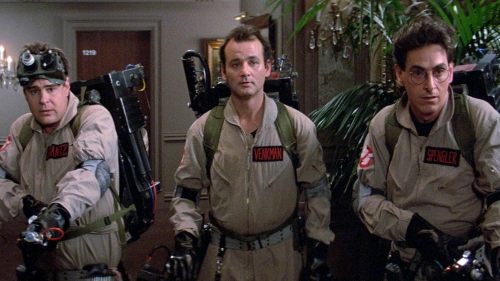Collins’ Crypt: Entering THE HOUSE THAT DRIPPED BLOOD
Over the past six years or so, horror anthologies have become a bit of "a thing" again, thanks to the likes of the V/H/S series, Chillerama, The XX, and several more. As a fan of the format, it's been a welcome change of pace, as it's been a long time since we've had any of note at all, let alone several. After Tales From The Hood's release in 1995, there wasn't another hitting mainstream theaters until the barely released Snoop Dogg's Hood Of Horror in 2007, and Tales itself was the first in nearly five years (info courtesy of BoxOfficeMojo*, which can be inaccurate - though I certainly don't recall any others beyond the occasional DTV indie). Of course, they weren't huge hits at the box office (the highest grossing of the lot is Twilight Zone, with $29m), so it's not exactly rocket science to figure out why Hollywood wasn't churning them out, or why the more recent ones tend to be limited/VOD releases.
Still, it must have been fun for horror fans in the '80s to be able to catch the likes of Creepshow (and its sequel), Cat's Eye, and Tales From The Darkside at their favorite multiplex, though all of Hollywood combined couldn't match the output and pace set by Amicus in the '60s and '70s. Starting with 1965's Dr. Terror's House of Horrors, they released at least seven anthology films, wrapping it up with 1974's From Beyond The Grave, while also producing traditional genre films like The Deadly Bees and I, Monster. Unlike Hammer Films, Amicus' productions tended to be set in the modern day and have a little more comedy in their presentation, which is quite evident in 1971's The House That Dripped Blood, which was their third (and, per many critics, best) anthology entry. I had watched it a while back for Horror Movie A Day, but didn't remember much (in fact I forgot I had seen it entirely until I found my own review while looking to see which of the Amicus anthologies I missed!), so it was fun to revisit and also discover that I ended up liking one segment a lot more than I did the first time.
Like the best anthologies, there's a framing device that introduces the stories, but what makes this one a bit different is that the wraparound has its own compelling narrative. Usually it's just someone telling the stories to pass the time or just for no real reason at all, but there's a legitimate explanation for why wraparound protagonist John Bennett is being told these tales - he is investigating the disappearance of a film star, and that star just happened to be living in the same house that a number of other people disappeared or died. This also keeps a visual consistency between the stories, as all four of them (plus the wraparound) spend a good chunk of their runtime inside of the titular house (which doesn't drip blood, for the record - in fact, the film is entirely blood free), though director Peter Duffell was smart enough to set the bulk of each one's action in different areas. He utilizes the main foyer entry and parlor for all of the stories to give us our bearings, but for the most part he keeps other rooms specific to one entry (the first one, for example, is the only one where we really see the kitchen area), so you're never getting tired of seeing people make themselves at home in the same rooms over and over. I realized a while back that it's possible the reason that anthologies fail to connect with audiences is that their episodic nature keeps their trailers too "busy" and don't allow anyone to really latch onto anything, something this one wouldn't have to worry about as much since it had the one location to show off throughout a trailer.

It also had Christopher Lee and Peter Cushing, both of whom had appeared in Dr. Terror's House of Horrors (Cushing appeared in all but one of their anthologies, in fact; Lee only popped up in a couple), which was always a surefire way to win over horror fans (and still is). But it also added Ingrid Pitt to the mix at the peak of her fame in horror, having just starred in Countess Dracula and The Vampire Lovers, which I'm sure pissed someone at Hammer off, with their rival getting all three of their big guns in one movie (albeit not sharing any scenes). It's also got a number of other folks who you'll recognize: Jon Pertwee from Doctor Who, Denholm Elliott, Joss "DIPLOMATIC IMMUNITY!!!" Ackland, and The Great Escape's Tom Adams all show up as well, and a number of them play against type, adding to the fun. Lee in particular is introduced as a stern, borderline sinister man who is looking after his daughter after the (vaguely explained) death of his wife, and you'd probably assume he was the villain of the piece - but no! We later learn his young daughter is actually a witch, and he lives in paralyzing fear of the girl, allowing us the rare chance to see him as a helpless victim as opposed to his usual malevolent types.
As for Cushing, he is unfortunately stuck in the movie's only "weak" link, playing a man who becomes obsessed with a wax figure. Cushing's great as always (and he's got some wonderfully flamboyant wardrobe), and I wouldn't call the segment "bad", but it's not as fun as the others and it barely even involves the house, with all of the action occurring in the wax museum, so it sticks out a bit. Luckily it's the second story, so it's of no real consequence - it comes once we're already on board (thanks to the setup and the quite good Denholm Elliott tale, about an author who starts seeing his murderous creation stalking him), and there's still plenty of time to win us back over. I mean, ideally all of the segments would be equally good, but if you have a lesser entry putting it second is probably the best place for the film's overall success.
My favorite of the lot was probably the final one, which finally gets down to the business of the missing film star. Pertwee plays the aging thespian, frustrated at the low production values of the newest horror film he's making (of over a hundred, we're told), in particular the bad cape they've given him. Taking matters into his own hands, he goes to a vintage costume shop and asks for a cape, thinking nothing of the fact that the owner has one locked in a little coffin-shaped box (itself kept inside of a closet) or of his announcement that he will now retire, having sold this random cape for literal pocket change. Surprising no one, the cape is haunted, turning whoever wears it into an actual vampire, the gradual development of which Pertwee plays for laughs until things get more traditionally scary (though still fun). It's a real high note to go out on, with the added bonus of a terrific little meta joke at Lee's expense, where Pertwee talks about how much he loves the classic monsters like Frankenstein and Dracula, adding that he means Lugosi, "not this new fellow". This is the one I didn't think much of the first time around, so I'm not sure what about me changed in the eight years since, but I'm glad I came around on it - it's so fun!

But even back then, what I liked most about this last segment is how it directly tied into the wraparounds, as opposed to being "just another story". In several of the Amicus productions, we'd meet all of the protagonists of each story in the wraparound, such as in Tales From The Crypt, where all five of them are wandering around the titular crypt when they meet the Crypt Keeper, who tells them how they will die. Nothing against that sort of thing, but it makes the last story of no more real interest than the first; there's something sneaky fun about presenting a few stories with a vague connection to the bookending segments, allowing the final tale's much stronger connection to come as a bit of a surprise. Tales From The Hood did this brilliantly, with the reveal that the person killed in the final story was murdered by the three guys that were listening to it being told, and I liked how Chillerama's framing device paved the way for a full blown segment (zombies overrunning the drive-in that was showing all the mini movies we just saw). It makes it feel more like a full on narrative experience as opposed to an episodic collection of tales that could have been told in any order; the climax of the final segment blends into the bookend narrative, so it couldn't have been placed anywhere else in the movie (whereas the other three segments could have been mixed around in the sequence).
Amicus did four more anthologies after this (they actually refer to them as "portmanteau films", for the record), and I've never seen one I disliked, though I have yet to see Vault of Horror or Dr Terror's House of Horrors. It's a bummer that the rights are so spread out, as it will likely prevent a boxed set from ever coming along, but they're worth tracking down (Scream Factory has also released Vault and Tales From The Crypt on a double feature disc). And they make for ideal Halloween time viewing, so if you've never seen any of them I'd suggest obtaining them over the next few months so you're well stocked when the season comes. At this point I don't know if we're ever going to see the promised Trick R Treat sequel (though maybe the Universal Horror Nights maze that was just announced will help regenerate interest), and there's a certain lack of mischievous fun to most of the newer films, so I'm happy that there are still one or two of the older ones like this that I haven't gotten around to seeing yet. They're just so damn charming, and I watch with a goofy grin on my face - here's hoping the recent "wave" of such films yields a couple more in this vein.
*BOM's list inexplicably counts the Eight Films To Die For as an anthology, but they were full length movies and you had to pay for tickets to each one separately. Their list also includes Grindhouse, which doesn't quite fit as they were complete films released together as a double feature.



